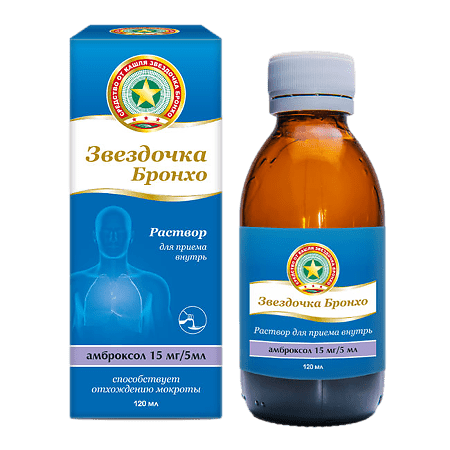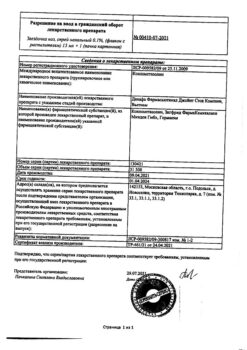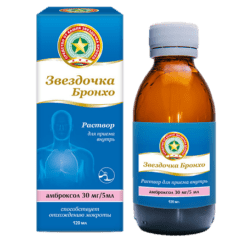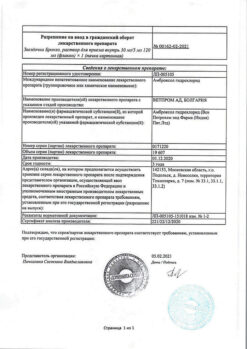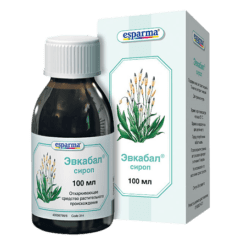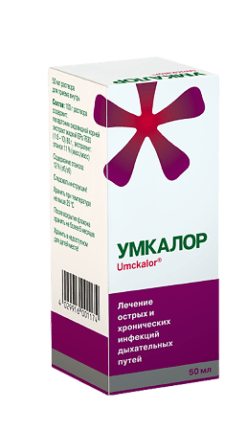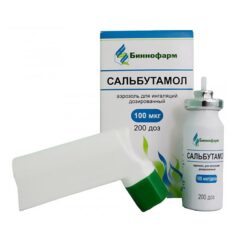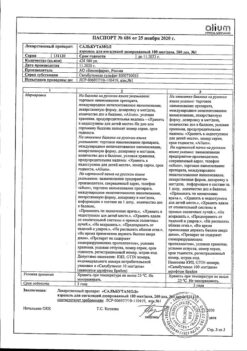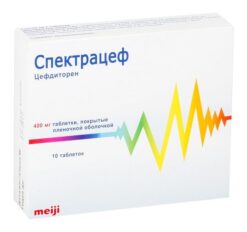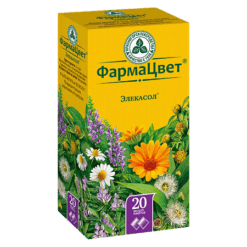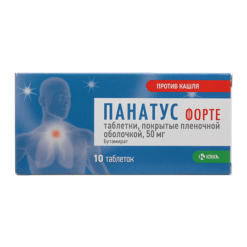No products in the cart.
Star Broncho, 15 mg/5 ml 120 ml
€6.81 €5.96
Description
Mucolytic and expectorant, is an active N-demethylated metabolite of bromhexine. It has secretomotor, secretolytic and expectorant action. It stimulates serous cells of bronchial mucosa, increases motor activity of atomizing epithelium by effect on type 2 pneumocytes in alveoli and Clara cells in bronchioles, increases formation of endogenous surfactant – surface-active substance, providing gliding of bronchial secretion in airway lumen.
Ambroxol increases the proportion of the serous component in the bronchial secretion, improving its structure and helping to reduce the viscosity and liquefy sputum; this improves mucociliary transport and facilitates removal of sputum from the bronchial tree.
When ambroxol is taken orally, the effect, on average, occurs within 30 minutes and lasts for 6-12 hours, depending on the single dose.
Pharmacokinetics
Ambroxol is quickly and almost completely absorbed after oral administration. Tmax is 1-3 h. Binding to plasma proteins is approximately 85%. It penetrates the placental barrier and is excreted with breast milk. Metabolized in the liver to form metabolites (dibromanthranilic acid, glucuronic conjugates), which are excreted by the kidneys. Excreted mainly by the kidneys – 90% as metabolites, less than 10% unchanged. T1/2 from plasma is 7-12 hours. T1/2 of ambroxol and its metabolites is approximately 22 h.
Due to high binding to proteins and large Vd and slow reverse penetration from tissues into blood, no significant excretion of ambroxol occurs during dialysis or forced diuresis. Ambroxol clearance in patients with severe hepatic failure is reduced by 20-40%. In severe renal failure, the T1/2 of ambroxol metabolites is increased.
Indications
Indications
Acute and chronic diseases of the respiratory tract, accompanied by the release of viscous sputum:
acute and chronic bronchitis;
pneumonia;
chronic obstructive pulmonary disease;
bronchial asthma with difficult sputum discharge;
bronchiectasis.
Pharmacological effect
Pharmacological effect
Mucolytic and expectorant, is the active N-demethylated metabolite of bromhexine. It has secretomotor, secretolytic and expectorant effects. Stimulates serous cells of the bronchial mucosa, increases the motor activity of the ciliated epithelium by affecting type 2 pneumocytes in the alveoli and Clara cells in the bronchioles, enhances the formation of endogenous surfactant – a surfactant that ensures the sliding of bronchial secretions in the lumen of the respiratory tract.
Ambroxol increases the proportion of the serous component in the bronchial secretion, improving its structure and helping to reduce viscosity and thin the sputum; as a result, mucociliary transport improves and the removal of sputum from the bronchial tree is facilitated.
When ambroxol is taken orally, the effect, on average, occurs after 30 minutes and lasts 6-12 hours, depending on the single dose.
Pharmacokinetics
After oral administration, ambroxol is quickly and almost completely absorbed. Tmax is 1-3 hours. Plasma protein binding is approximately 85%. Penetrates the placental barrier and is excreted in breast milk. Metabolized in the liver to form metabolites (dibromanthranilic acid, glucuronic conjugates), which are excreted by the kidneys. It is excreted primarily by the kidneys – 90% in the form of metabolites, less than 10% unchanged. T1/2 from plasma is 7-12 hours. T1/2 of ambroxol and its metabolites is approximately 22 hours.
Due to high protein binding and large Vd, as well as slow re-penetration from tissues into the blood, significant elimination of ambroxol does not occur during dialysis or forced diuresis. The clearance of ambroxol in patients with severe liver failure is reduced by 20-40%. In severe renal failure, T1/2 of ambroxol metabolites increases.
Special instructions
Special instructions
Ambroxol should not be taken simultaneously with antitussive drugs that can inhibit the cough reflex, for example, codeine, because this may make it difficult to remove liquefied mucus from the bronchi.
Ambroxol should be used with caution in patients with a weakened cough reflex or impaired mucociliary transport due to the possibility of sputum accumulation.
Patients taking ambroxol are not recommended to perform breathing exercises due to difficulty in sputum discharge. In critically ill patients, aspiration of liquefied sputum should be performed.
You should not take ambroxol immediately before bed.
In patients with bronchial asthma, ambroxol may increase cough.
In patients with severe skin lesions – Stevens-Johnson syndrome or toxic epidermal necrolysis – a flu-like condition may be observed in the early phase: fever, body pain, rhinitis, cough, pharyngitis. During symptomatic therapy, it is possible to erroneously prescribe mucolytic drugs such as ambroxol hydrochloride.
Active ingredient
Active ingredient
Ambroxol
Composition
Composition
5 ml of oral solution contains:
active ingredient:
ambroxol hydrochloride 15.00 mg;
excipients:
citric acid monohydrate 1.00 mg,
liquid sorbitol 70% 2250.00 mg,
glycerol 860.00 mg,
methyl parahydroxybenzoate 6.00 mg,
propyl parahydroxybenzoate 1.5 mg,
propylene glycol 150.00 mg, strawberry flavor 2.50 m,
purified water up to 5 ml.
Contraindications
Contraindications
hypersensitivity to ambroxol, bromhexine or other components of the drug;
hereditary fructose intolerance (due to the fact that the drug contains sorbitol);
Pregnancy (first trimester);
breastfeeding period;
children under 6 years of age (for a dose of 30 mg/5 ml);
In children under 2 years of age, the drug can only be used as prescribed by a doctor.
With caution
pregnancy (II-III trimester);
liver failure;
renal failure;
peptic ulcer of the stomach and duodenum in the acute stage;
impaired bronchial motor function and increased sputum production (with immotile cilia syndrome).
Side Effects
Side Effects
Allergic reactions: rarely – skin rash, urticaria, exanthema, facial swelling, shortness of breath, itching, fever; frequency unknown – anaphylactic reactions, including anaphylactic shock, angioedema, itching, allergic contact dermatitis.
From the digestive system: often – nausea; uncommon – vomiting, diarrhea, dyspepsia, abdominal pain.
From the nervous system: often – dysgeusia.
From the skin and subcutaneous tissues: very rarely – toxic epidermal necrolysis (Lyell’s syndrome), Stevens-Johnson syndrome; frequency unknown – acute generalized eczematous pustulosis.
From the respiratory system: often – decreased sensitivity in the mouth or pharynx; rarely – dryness of the mucous membrane of the respiratory tract, rhinorrhea; in isolated cases – dryness of the pharyngeal mucosa.
Interaction
Interaction
Ambroxol should not be taken simultaneously with antitussives, due to the possible suppression of the cough reflex and retention of secretions in the respiratory tract.
Ambroxol should not be taken simultaneously with drugs that suppress bronchial secretions.
Ambroxol increases the penetration of certain antibiotics (for example, amoxicillin, cefuroxime, erythromycin, doxycycline) into the lung tissue and, therefore, increases their concentration in the lung parenchyma.
Overdose
Overdose
Specific symptoms of overdose in humans have not been described. There have been reports of accidental overdose resulting in symptoms of known side effects of ambroxol: nausea, dyspepsia, diarrhea, vomiting, abdominal pain.
Treatment: artificial vomiting, gastric lavage in the first 1-2 hours after taking the drug, symptomatic therapy. Due to the high degree of binding of ambroxol to plasma proteins and the large volume of distribution, hemodialysis or forced diuresis is not advisable.
Recommendations for use
Recommendations for use
Inside, after eating.
The mucolytic effect of the drug occurs when taking large amounts of liquid. Therefore, drinking plenty of fluids is recommended during treatment. The drug should not be taken immediately before bedtime.
For dosing, use a teaspoon.
Adults and children over 12 years old
During the first 2-3 days, take 10 ml (30 mg) of the oral solution 3 times a day, then the dose should be reduced to 10 ml (30 mg) of the oral solution 2 times a day.
Children from 6 to 12 years old
5 ml (15 mg) solution for oral administration 2-3 times a day.
Children from 2 to 6 years old
2.5 ml (7.5 mg) solution for oral administration 3 times a day.
Children under 2 years of age
2.5 ml (7.5 mg) solution for oral administration 2 times a day.
Manufacturer
Manufacturer
Vetprom AD, Bulgaria
Additional information
| Manufacturer | VetProm AD, Bulgaria |
|---|---|
| Medication form | oral solution |
| Brand | VetProm AD |
Other forms…
Related products
Buy Star Broncho, 15 mg/5 ml 120 ml with delivery to USA, UK, Europe and over 120 other countries.

